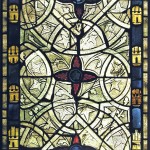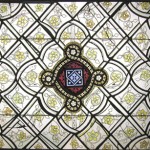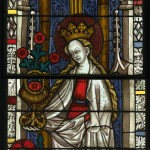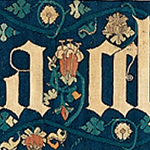Above: Two details from a tapestry-woven praetexta (Germany, Cologne, about 1450-75) currently on display at The Cloisters. The??flower shown at the center??of the detail on the??left is a fantasy.??The detail on the??right??shows a botanically unmistakable lily;?? a strawberry, embellished with a fanciful??and botanically incorrect??element at the??bottom of the fruit,??appears just below and to the left of the lily.?? See the full image.
A plant in a medieval work of art need not be naturalistically depicted to be recognizable. Even a very stylized representation may have characteristics so distinctive that it can be given a botanical identity with complete confidence. If a berry in a medieval work of art is capped with a fringe, large or small, that may be read as “hull” and rendered with little dots that may be read as “seeds” we can be sure it is Fragaria vesca, however stylized or simplified. The strawberry is the only hulled fruit in the medieval European flora with many small seeds borne on the outside of the berry. (Botanists call this type of fruit an achene.) If the characteristic compound leaves with three leaflets each??and the five-petaled flower of the strawberry are shown, all the better, but we don???t need them. Even significant departures from other aspects of botanical reality are of no moment.????The fruit??may be given an??additional filip like the strawberry shown above.?? It may be round, heart-shaped, or elongated; it may be blue or yellow instead of red. It???s a strawberry.
Color is the least reliable clue to an artistically rendered plant???s identity. The common daffodil, Narcissus pseudo-narcissus, often appears in medieval art; the form is readily recognizable, even when stylized. It is the only trumpet-flowered narcissus species known to the Middle Ages, and both the cup and the petals that form the corolla are yellow. The many bicolored forms of trumpet narcissus known to us include apricot-colored and even pink daffodils. These are the result of modern plant breeding. We do find daffodils with apricot cups and yellow-green corollas, as well as white cups and blue-white corollas, among the many beautiful and naturalistically rendered flowers in the borders of a book of hours painted for Englebert of Nassau by the Master of Mary of Burgundy now in the collection of the Bodleian Library (see images from this work). Both these fanciful variations have also been embellished with gold. There is no doubt that the flower of Narcissus pseudo-narcissus is represented here, but??five centuries would pass before the color of these artistically rendered flowers??could be found??in nature.
Below, from left to right: A highly stylized but recognizable rendering of juvenile ivy in a French grisaille lancet, ca. 1265, from Rouen, in Normandy. Stylized plant forms in a French grisaille lancet, ca. 1325, from the abbey church of Saint Ouen at Rouen; only one of the forms may be tentatively identified. The stylized red flowers in the basket held by Saint Dorothea in this German stained glass panel, ca. 1440-46, from Boppard-Am-Rhein, are identifiable as roses.
 |
 |
 |
???Deirdre Larkin
Source:
The Master of Mary of Burgundy: A Book of Hours for Engelbert of Nassau (The Bodleian Library, Oxford). Introduction and Legends by J. J. G. Alexander. New York: George Braziller, 1970.
Tags: achene, berry, Fragaria vesca, hull, lily, Narcissus pseudo-narcissus, seeds, strawberry


